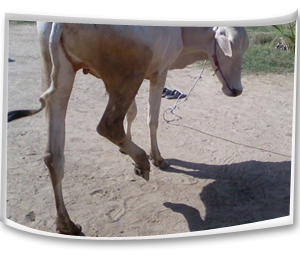|
Foot Rot
| Nature of disease |
|
- This is an infectious disease of animals characterized by inflammation, necrosis and ulceration of the interdigital space, coronary bands and posterior limbs resulting to lameness.
|
| |
Causes |
- This disease is caused by Spherophorous necrophorus. (Fusiformis necrophorus).
- It is a normal inhabitant of the ruminant digestive tract.
|
| Mode of Transmission |
|
- The disease is influenced by factors which help in the breakdown of skin such as continuous wet and muddy condition or rough ground.
- Damage by the tick or penetration of skin by Strongyloides papilosa larvae have been identified as conducive agent for transmission.
- Warm wet environment (20-25˙C), Soil, Manure, Beddings act as source of infection.
|
|
 |
| Clinical symptoms |
 |
- Lameness is the cardinal sign.
- Moist and reddened interdigital cleft
- The skin of the interdigital space shows ulcerative changes.
- Separation of the horny tissues and characteristic foul odour.
- Affected animals may kick on the ground and disincline to move or try to move on two legs due to pain.
- Infect one or more feet at the same time.
- There is elevation of body temperature, anorexia and loss of body weight.
|
 |
|
 |
| Control measures |
|
- Animal should be placed on dry, smooth surface in indoor condition.
- Infected animals should be separated from the rest.
- Foot bath should be given with 5% copper sulphate.
- Foot trimming should be done at least two times per year.
- Foot baths/foot soaks-formaldehyde/ phenols- should be used 1-2 times per week for several weeks and may also be used routinely after foot trimming and as a preventive measure.
- Zinc sulphate (10% solution) or copper sulphate (10%solution) may be used for footbaths.
- Vaccine will aid in reducing the level of infection.
- Two vaccines subcutaneously on the neck region 4-6 weeks apart.
- Vaccination before the start of the wet season is recommended followed by a booster each year prior to the wet season.
|
|
 |
|